Innovation management platforms have become essential tools for businesses in 2025, helping organizations streamline idea generation, evaluation, and implementation processes. These platforms cater to different needs, from trend analysis to business model validation, and offer features like AI-driven analytics, collaboration tools, and integration with enterprise systems. Here’s a quick look at the top platforms:
- ITONICS: Focuses on trend research and foresight; premium pricing starting at $10,000 annually.
- Brightidea: Offers end-to-end innovation management; trusted by Fortune 500 companies.
- Strategyzer: Specializes in business model validation using structured frameworks.
- IdeaScale: User-friendly platform for community-driven idea sharing.
- Planbox: Supports tech scouting and corporate venturing with flexible workflows.
- Qmarkets: Scalable solution with AI tools and multi-language support.
- HYPE Innovation: Comprehensive modules for enterprise-level innovation.
- InnovationCast: Balanced features for mid-sized organizations.
- IdeaWake: Simple and quick deployment for smaller teams.
- Aha! Ideas: Ideal for product-focused teams with pricing starting at $39/user/month.
Quick Comparison
| Platform | Best For | Key Features | Price Starting At | User Ratings |
|---|---|---|---|---|
| ITONICS | Trend analysis | Advanced visualization, foresight | $10,000 annually | Not specified |
| Brightidea | Large enterprises | ROI tracking, workflow automation | Custom pricing | 4.2/5 |
| Strategyzer | Business model validation | Business Model Canvas, collaboration | Custom pricing | 4.3/5 |
| IdeaScale | Community engagement | Easy setup, flexible customization | Custom pricing | Not specified |
| Planbox | Tech scouting | AI tools, gamification | $20,000 annually | 4.6/5 |
| Qmarkets | Enterprise ecosystems | AI-powered analytics, scalability | $1,500/month | 4.5-4.7/5 |
| HYPE Innovation | Enterprise innovation | Idea challenges, collaboration tools | Custom pricing | 4.3/5 |
| InnovationCast | Mid-sized businesses | Structured workflows, collaboration | Custom pricing | Not specified |
| IdeaWake | Simplicity | User-friendly, quick deployment | Custom pricing | Not specified |
| Aha! Ideas | Product teams | AI scoring, roadmap integration | $39/user/month | 8.7/10 |
Each platform offers distinct strengths, so choosing the right one depends on your organization's size, goals, and budget. Start by identifying your needs, then explore demos or trials to find the best fit.
10 Best Idea Management Software for Businesses – 2025 Edition
1. ITONICS
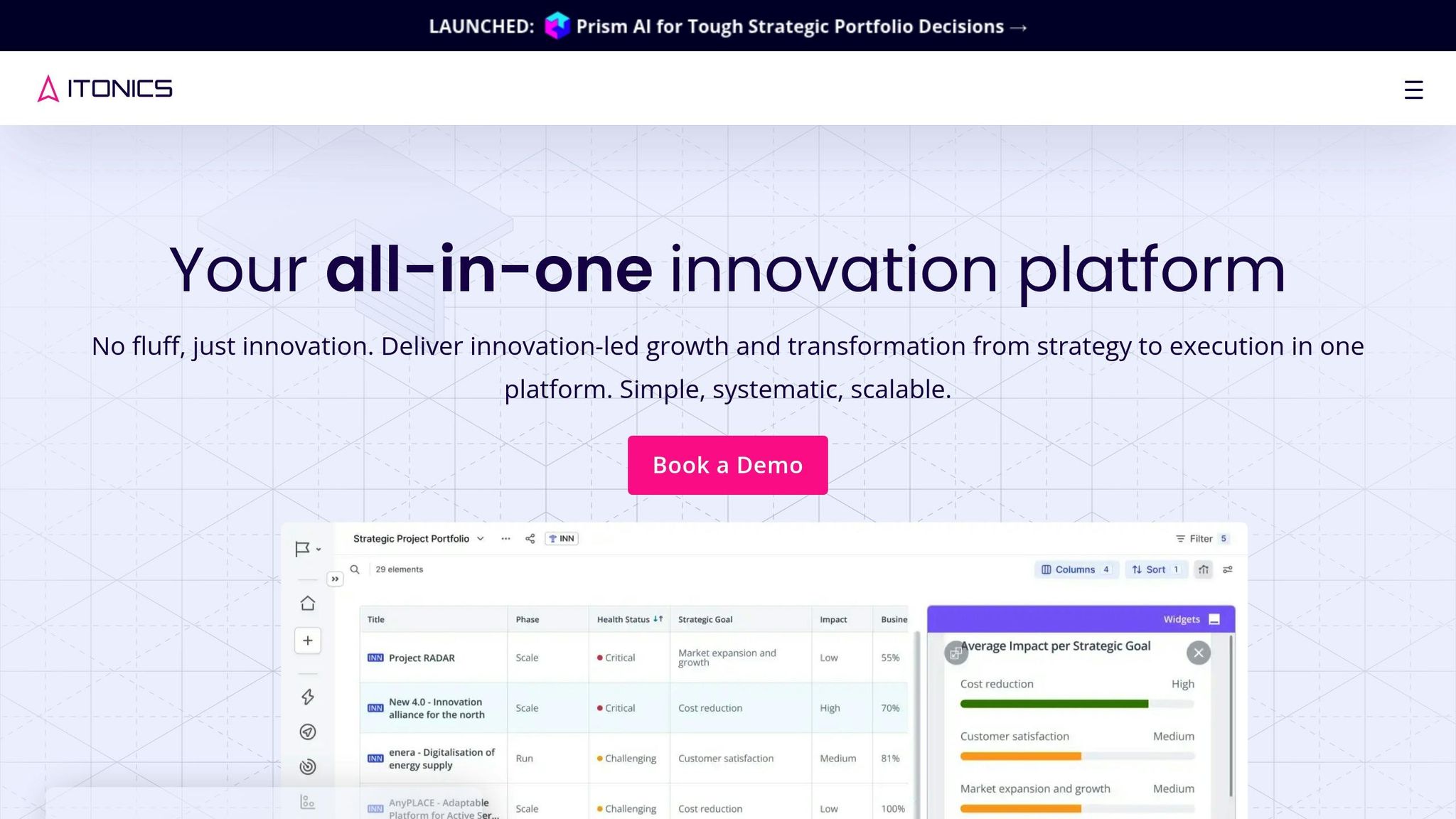
ITONICS positions itself as a high-end innovation management platform, focusing on three main areas: foresight, ideation, and portfolio management. It has gained recognition in industry rankings for 2025, catering to organizations that prioritize a structured approach to innovation [1, 4, 5].
Designed for Innovation and Foresight Managers, ITONICS offers powerful tools for trend research, signal detection, and managing innovation portfolios. Let’s dive into its key features.
Idea Capture and Management
One of ITONICS’ standout features is its ability to crowdsource ideas effectively. Teams can systematically explore trends, signals, technologies, and startups using its advanced tools. Its proprietary databases provide curated market intelligence, helping users make informed decisions.
The platform also includes visualization tools, such as radar charts, which make it easier to map and analyze trends. These tools help users present findings clearly to stakeholders and spot emerging opportunities or potential risks. However, ITONICS lacks robust modules for managing partnerships and projects, which could be a drawback for organizations that need to coordinate innovation efforts with external collaborators or handle complex projects.
Integration Capabilities with Other Software
While ITONICS ensures high-quality data through its proprietary databases, this approach can limit its ability to integrate with existing enterprise systems. Users might encounter difficulties when trying to incorporate data from other business tools or external databases already in use.
Pricing Models
ITONICS adopts a premium pricing model, making it one of the more expensive options in the innovation management space. For individual users, annual costs start at over $10,000, while organizations deploying the platform for 100 users can expect to pay upwards of $100,000 annually. This pricing reflects its enterprise-level features and is best suited for large organizations with dedicated innovation teams and sizable innovation portfolios that can justify the investment.
2. Brightidea
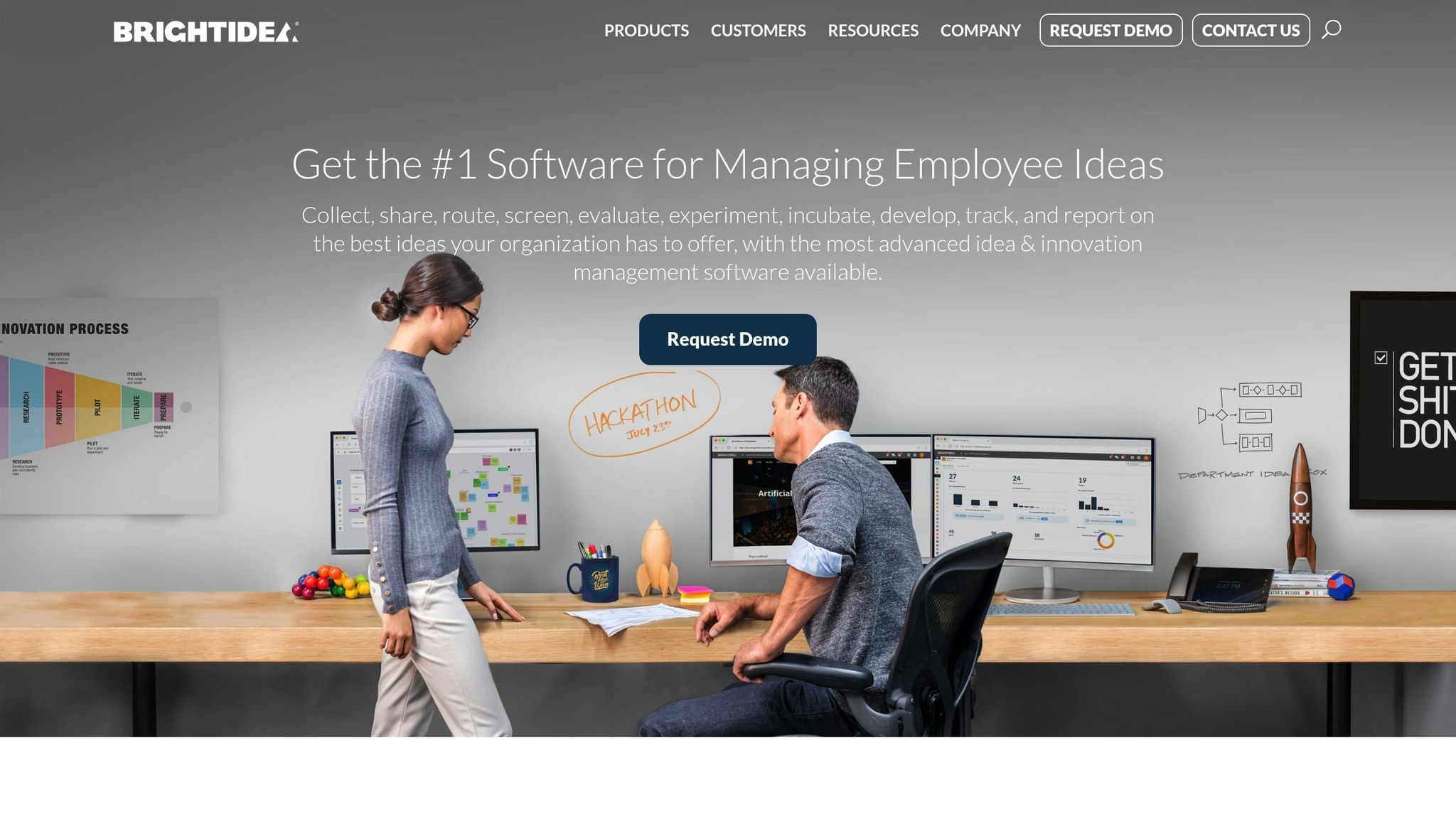
Brightidea continues to gain traction in 2025, boasting over 2 million users and helping organizations manage billions in innovation pipeline value. Trusted by Fortune 500 companies for delivering tangible results, Brightidea supports every stage of the innovation process - from capturing initial ideas to measuring their return on investment (ROI). Its well-designed platform streamlines idea management and evaluation, making it a go-to choice for businesses.
Idea Capture and Management
Brightidea excels at managing ideas with its advanced tools and features. It offers customizable submission forms, which can be tailored to specific challenges or departmental needs. Organizations can define evaluation criteria, set up approval workflows, and design routing processes that align with their innovation objectives.
The platform’s workflow automation ensures ideas progress smoothly through each evaluation stage, reducing bottlenecks. Built-in analytics provide detailed insights into idea progress, adoption rates, and measurable business outcomes, helping organizations focus on concepts that deliver real value. This structured approach prevents the common issue of collecting ideas without actionable results.
One of Brightidea’s standout features is its ability to track and showcase ROI from innovation efforts. Its comprehensive reporting dashboards go beyond simply counting ideas - they measure actual business impact and the success rates of implemented initiatives.
Collaboration and Engagement Tools
Brightidea encourages team collaboration with a suite of social tools designed to engage users. Features like voting, commenting, and real-time engagement foster teamwork and cross-functional participation throughout the innovation process.
The platform also incorporates gamification elements, which keep innovation programs lively and engaging. By recognizing contributors and introducing friendly competition, Brightidea motivates teams to stay active in generating ideas. Additionally, it supports crowdsourcing from a wide range of contributors, including employees, remote teams, customers, partners, and external stakeholders. This approach allows organizations to gather diverse perspectives while maintaining an organized evaluation framework.
Integration Capabilities with Other Software
Brightidea integrates smoothly with popular enterprise tools like Microsoft Teams, Slack, Jira, and Salesforce. Its API and pre-built connectors ensure compatibility with a variety of business software, including project management platforms, collaboration tools, and enterprise resource planning systems. This flexibility makes it easy to incorporate Brightidea into existing workflows.
Pricing Models
Brightidea operates on a tiered subscription model, with pricing based on factors like the number of users, feature modules, and support levels. Organizations receive tailored quotes depending on their specific needs, such as the scale of users, required modules, customization, implementation support, and ongoing maintenance. This structure allows businesses to pay for only the features and scalability they require, ensuring cost efficiency.
3. Strategyzer
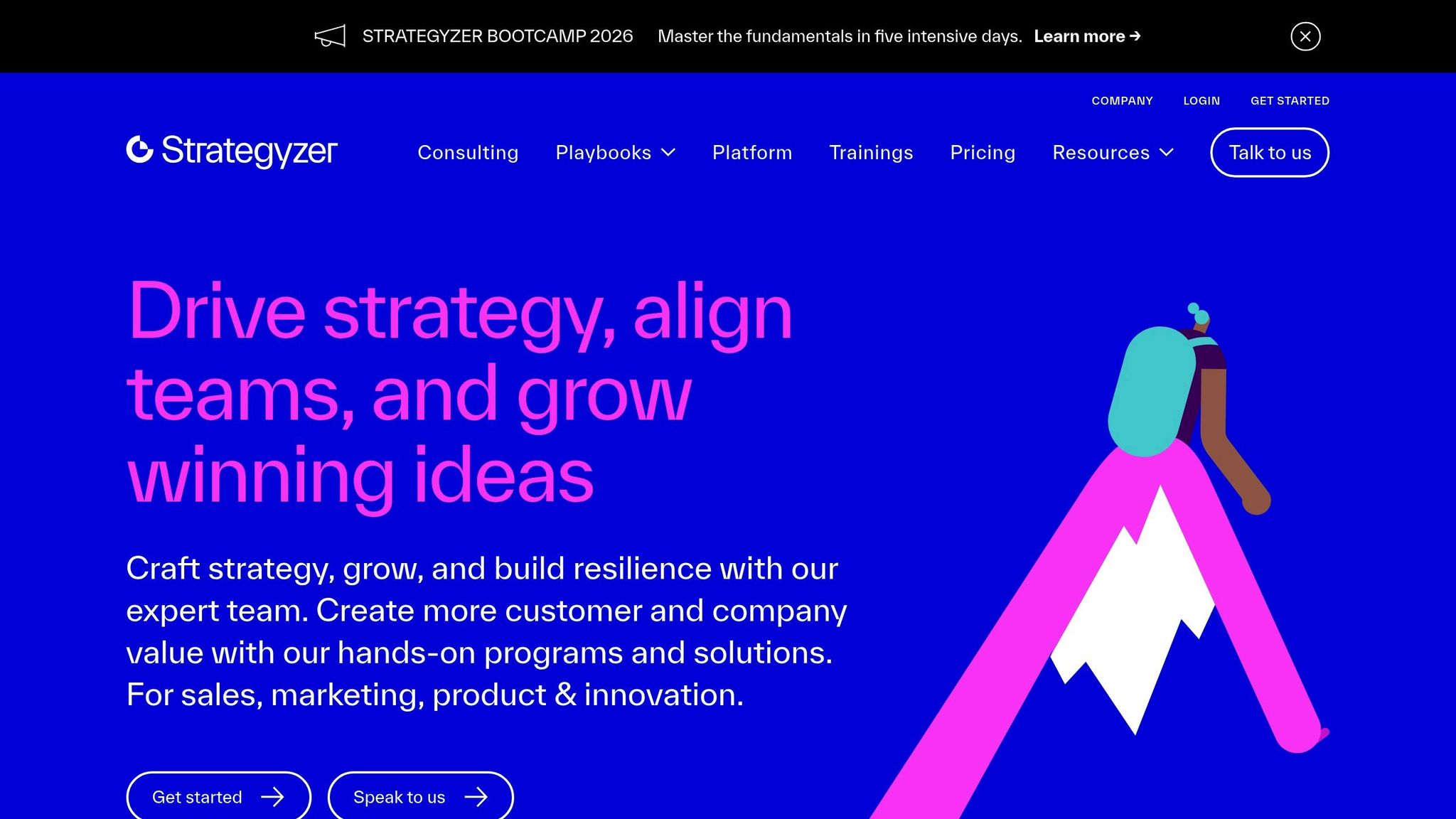
Strategyzer, created by the minds behind the Business Model Canvas, is an innovation platform tailored for business model validation. It’s earned a solid 4.3/5 rating on G2, reflecting its effectiveness in helping organizations craft and refine their business models with precision.
Unlike general idea management tools, Strategyzer zeroes in on business model design and validation. This makes it a go-to choice for teams aiming to build new models using structured, proven frameworks. By focusing on best practices, it minimizes the risks that come with poorly planned innovation. Let’s break down how Strategyzer turns its methodology into practical tools for idea capture, teamwork, and integration.
Idea Capture and Management
Strategyzer’s idea capture revolves around concise, character-limited virtual sticky notes. This feature pushes teams to clearly and succinctly articulate their ideas. The platform builds its process around established tools like the Business Model Canvas and Value Proposition Canvas, ensuring that every idea is carefully developed and tested. Templates and prompts guide users through each step, helping them focus on what matters most without overlooking key details.
Collaboration and Engagement Tools
Collaboration is one of Strategyzer’s standout features. It allows real-time team interaction without charging per user, making it accessible for teams of any size. The platform’s digital tools enable simultaneous work on business models, keeping sessions productive and aligned with clear goals. Its structured approach fosters deeper team engagement and ensures everyone is on the same page.
In addition to collaboration, Strategyzer integrates seamlessly with other tools to simplify documentation and presentations.
Integration Capabilities with Other Software
Strategyzer works well with Microsoft Office tools, particularly Excel and PowerPoint. This integration makes it easy to export business model canvases and value propositions into formats familiar to stakeholders. By bridging the gap between innovative concepts and traditional business workflows, it ensures ideas are not only developed but also effectively communicated.
Pricing Models
Strategyzer uses a subscription-based pricing model with no per-user fees, making it a cost-effective option for larger teams. Organizations should weigh the value of its structured methodologies and frameworks against the subscription cost, especially if their needs go beyond business model development.
4. IdeaScale
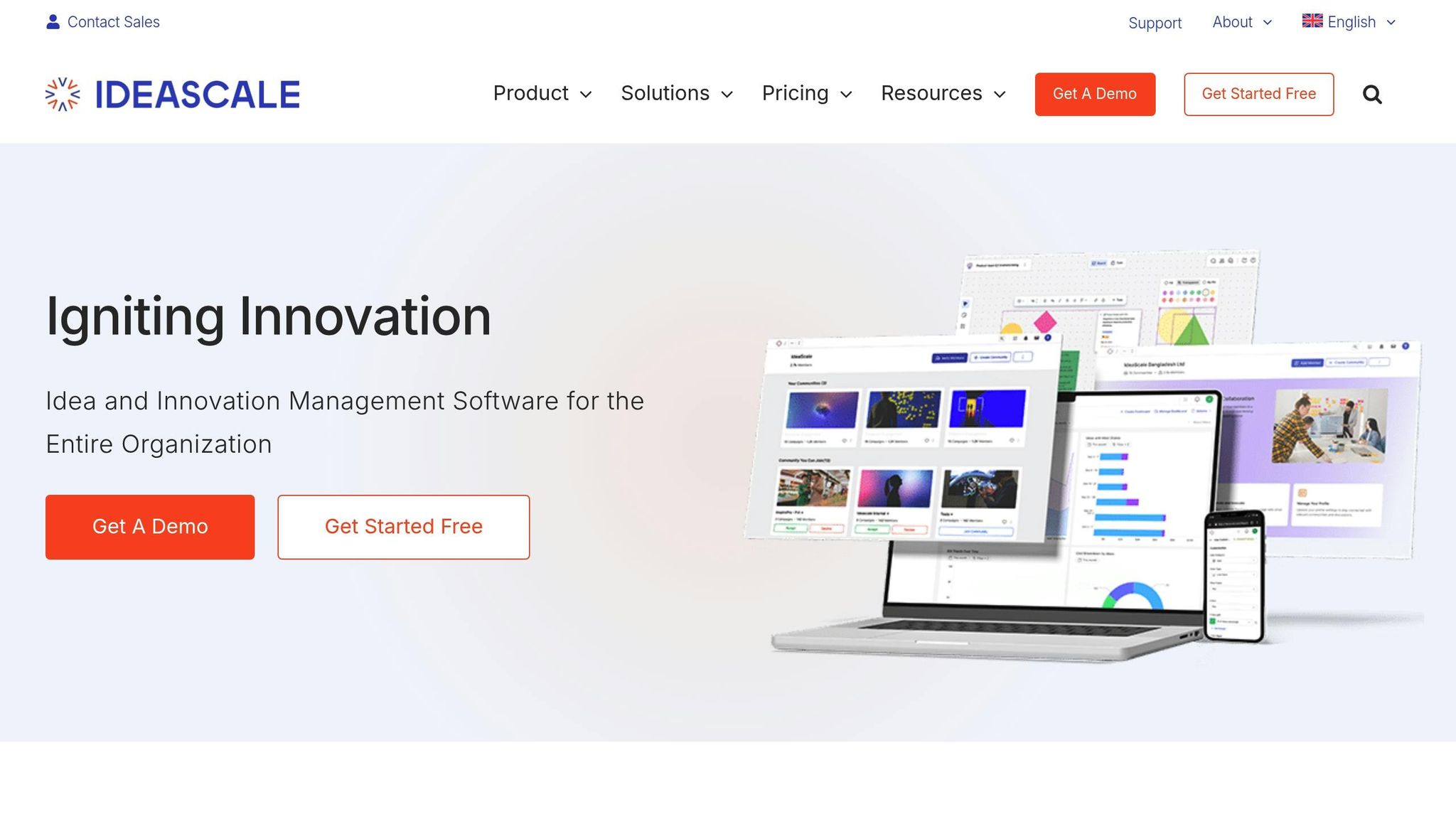
IdeaScale is an innovation platform designed to bring communities together by encouraging active participation and idea-sharing. With a solid 4.3/5 rating on G2, it stands out for its user-friendly interface and quick setup, making it accessible to teams across an organization.
Idea Capture and Management
One of IdeaScale's key strengths is its structured approach to gathering and managing ideas. The platform allows organizations to create tailored innovation campaigns, offering flexible customization options. This ensures that submitted ideas are evaluated and developed systematically, keeping the process organized and effective.
Collaboration and Engagement Tools
IdeaScale shines when it comes to community engagement. It enables users to share, comment on, and refine ideas collaboratively, fostering a team-driven approach to innovation. Thanks to its easy setup, organizations can quickly roll out initiatives without facing lengthy implementation delays.
Integration Capabilities with Other Software
For seamless workflow integration, IdeaScale supports Single Sign-On (SSO), providing secure and straightforward access. This ensures the platform fits smoothly into existing systems and processes.
Pricing Models
IdeaScale offers a cost-effective solution for managing innovation, focusing on boosting user participation and building a strong sense of community.
5. Planbox
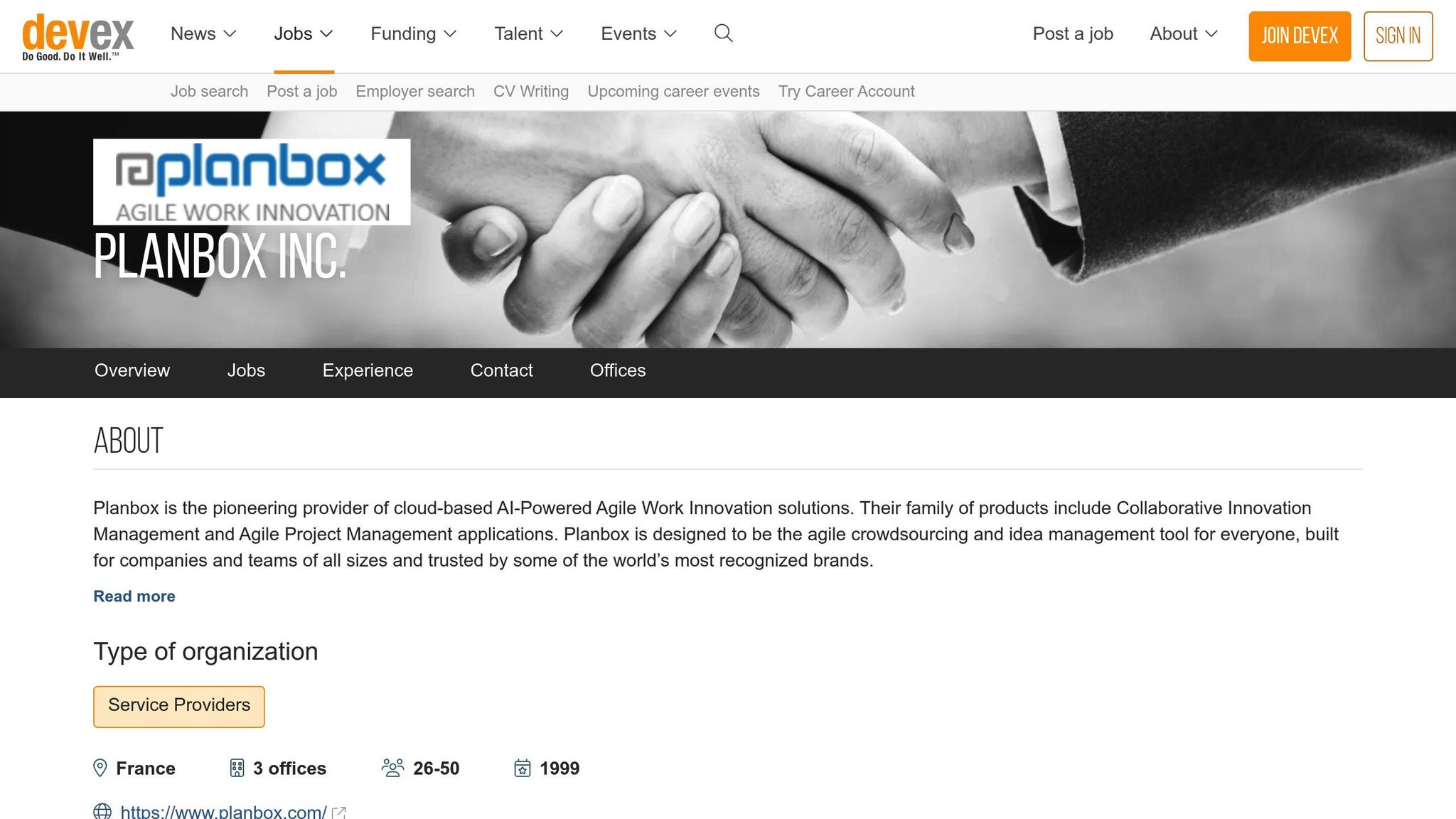
Planbox stands out as a leading innovation management platform, trusted by over 400 organizations, including many Fortune 500 companies. With a 4.6/5 rating on SoftwareReviews, users often highlight its user-friendly interface, flexibility, and excellent customer support. Let’s take a closer look at its key features, including idea management, collaboration tools, integrations, and pricing.
Idea Capture and Management
Planbox supports the entire innovation process, covering areas like tech scouting, corporate venturing, and both challenge-based and open innovation. It helps organizations track emerging technologies, discover investment opportunities, and crowdsource ideas from a wide range of contributors. With AI-driven analytics, the platform prioritizes ideas and predicts their potential impact. Its customizable design makes it suitable for handling even the most complex, multi-stage innovation workflows. Planbox also works closely with clients to create innovation processes tailored to their goals, offering ongoing support to adjust workflows as strategies evolve.
Collaboration and Engagement Tools
Collaboration is at the heart of Planbox, offering features like discussion threads, voting options, and gamification elements. These tools encourage teamwork and streamline agile innovation management, making it easier to adapt and iterate quickly.
Integration Capabilities with Other Software
Planbox integrates seamlessly with widely used tools, including Microsoft 365, Slack, Jira, and Salesforce. These integrations help automate workflows and ensure compliance with industry regulations through role-based access controls. The platform’s adaptability allows businesses to create solutions that meet their specific needs.
Pricing Models
Planbox operates on a custom, subscription-based pricing model. For mid-sized organizations, pricing starts at approximately $20,000 per year and scales depending on the size and complexity of the organization. However, its highly tailored configurations often require multiple consultations and a more intricate initial setup process.
6. Qmarkets
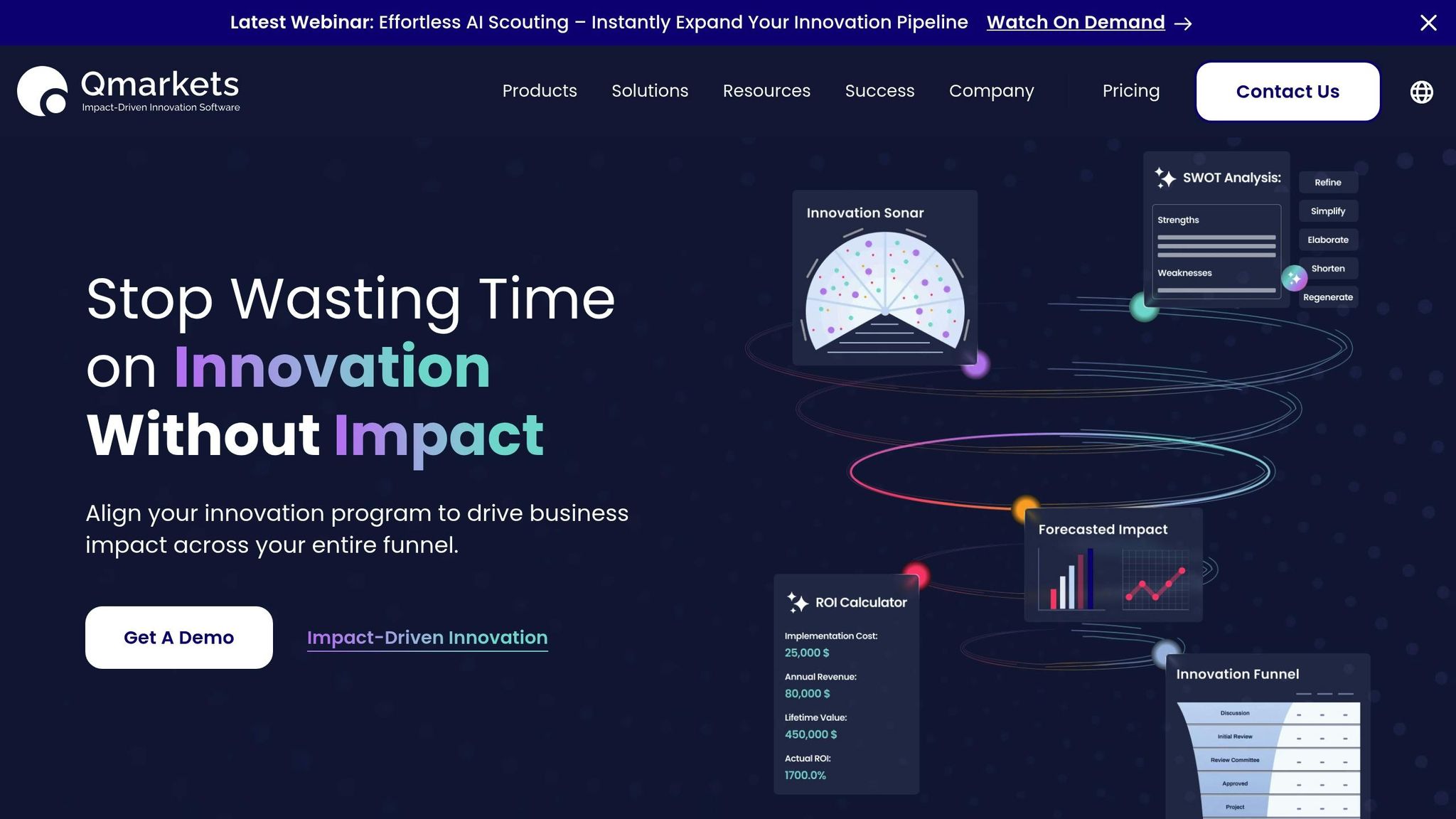
After exploring Planbox in detail, let’s turn our attention to Qmarkets - a powerful innovation management platform known for its flexibility and global reach.
Qmarkets serves over 1,000 organizations, including numerous Fortune 500 companies, and consistently earns high ratings of 4.5/5 to 4.7/5 on major review platforms. Users frequently highlight its customization options, worldwide support, and analytics tools as standout features. Designed to scale, Qmarkets supports everything from mid-sized businesses to large enterprises with intricate innovation needs.
Idea Capture and Management
Qmarkets shines in gathering, evaluating, and nurturing ideas from a variety of sources, such as employees, customers, and external partners. The platform employs structured workflows, enabling users to customize submission forms and automate idea routing to the appropriate stakeholders. Its advanced analytics tools allow organizations to track the progress of ideas and assess their impact over time.
With support for multi-language environments, Qmarkets is a great fit for global organizations with dispersed teams. Customizable criteria and scoring systems add flexibility to the idea assessment process. Stakeholders can evaluate submissions through rating systems, comments, and voting features. The platform’s AI-powered tools further enhance decision-making by identifying trends and spotlighting high-impact opportunities . These features promote a well-organized, collaborative environment for innovation.
Collaboration and Engagement Tools
One of Qmarkets' strengths lies in its ability to foster collaboration. The platform offers tools like discussion forums, voting mechanisms, and gamification features - such as badges and leaderboards - to motivate participation. Users can engage with ideas through comments, provide real-time feedback, and work together to refine concepts, creating a dynamic and interactive innovation culture.
Its user-friendly interface appeals to a broad range of users, from frontline employees to senior executives. By encouraging widespread participation, these collaboration tools not only boost idea submissions but also improve the success rates of innovation projects, delivering measurable returns.
Integration Capabilities with Other Software
Qmarkets extends its functionality through robust integration options, making it a seamless addition to existing enterprise systems. The platform provides API access and pre-built connectors for popular tools like Microsoft Teams, Slack, SAP, Jira, and Salesforce . These integrations embed innovation processes into daily workflows, ensuring organizations can leverage their current IT infrastructure effectively.
Key integration features include single sign-on (SSO), data synchronization, and automated notifications, allowing for smooth cross-platform collaboration. This adaptability helps organizations maintain consistent workflows and data accuracy across their technology stack.
Pricing Models
Qmarkets uses a subscription-based pricing model, with packages varying based on the number of users and required features. Entry-level plans start at $1,500 per month, catering to smaller teams. For larger enterprises, custom pricing is available, scaling with organizational size and complexity.
The platform also offers flexible licensing options to meet diverse needs. However, additional charges may apply for premium features like advanced analytics, AI tools, and certain integrations. While the initial setup can be complex and premium costs may add up, many organizations find the platform’s scalability and customization worth the investment for serious innovation initiatives .
sbb-itb-d1a6c90
7. HYPE Innovation
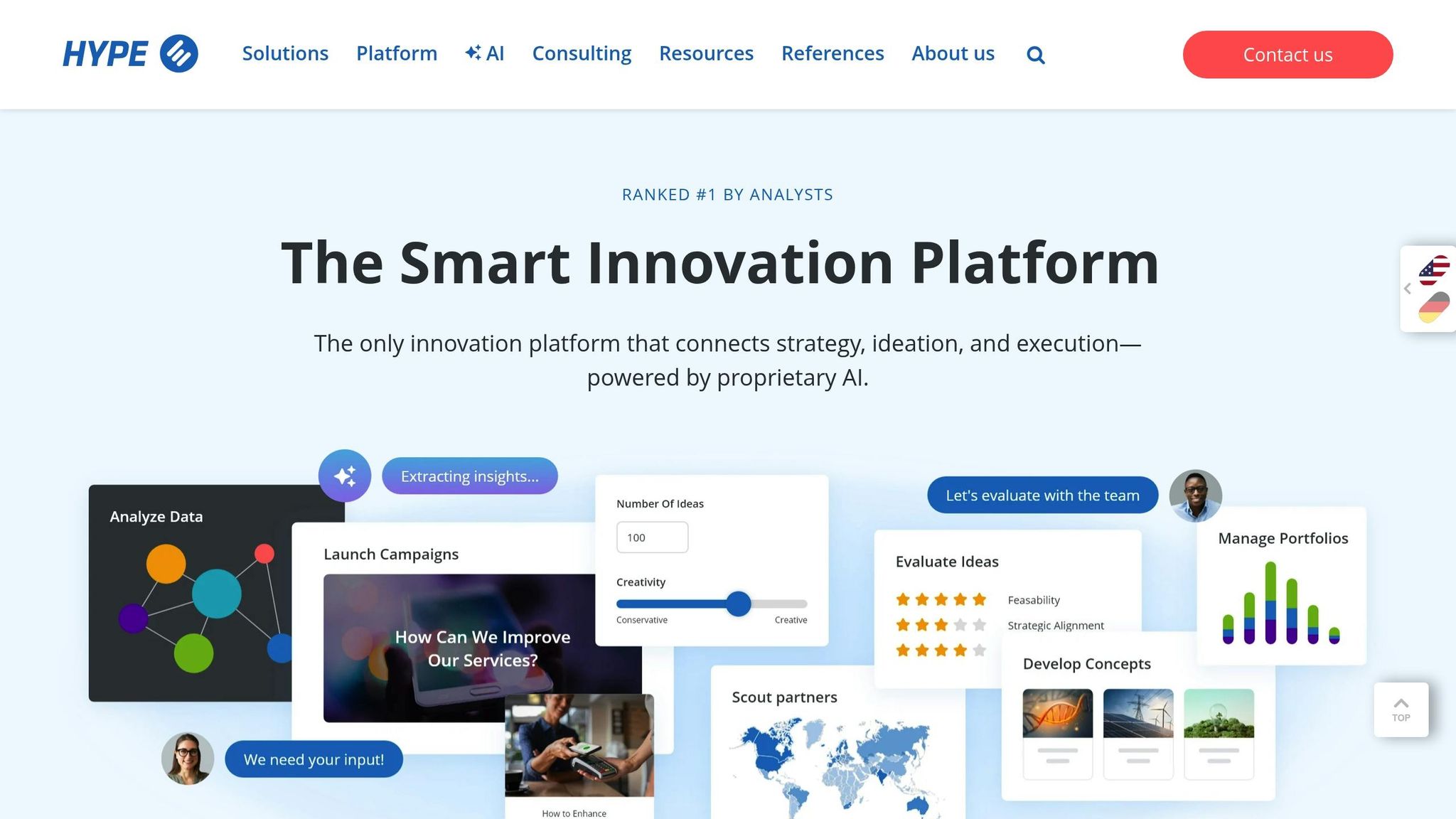
HYPE Innovation is one of the longest-standing innovation platforms available today. It has earned a spot among the Top 10 Innovation Management Platforms of 2025, as recognized by Traction AI. This acknowledgment was based on factors like product capabilities, AI-driven features, market presence, and the ability to deliver measurable results in innovation management.
What sets HYPE Innovation apart is its all-in-one solution designed to handle everything from internal improvements to enterprise-level innovation strategies. The platform includes modules for Innovation Management, Idea Management, and Idea Challenges, making it a comprehensive choice for organizations looking for diverse functionality in one place. Like other leading platforms, HYPE Innovation focuses on structured processes for managing ideas and achieving tangible outcomes.
Idea Capture and Management
HYPE Innovation stands out with its powerful tools for collecting and managing ideas. Organizations can use the platform to systematically gather, evaluate, and implement concepts from various sources. It supports both internal initiatives and external challenges, engaging employees and stakeholders in well-organized processes. The platform's customization options are a big plus, allowing companies to adjust submission forms, evaluation criteria, and approval workflows to align with their specific needs. However, the initial setup can be complex and might require certified third-party assistance.
Collaboration and Engagement Tools
To complement its idea management features, HYPE Innovation includes collaboration tools that encourage participation in structured campaigns. Users can contribute ideas, provide feedback, and work together on refining concepts into actionable projects. The platform supports targeted challenges and team-focused activities, fostering a collaborative environment. That said, some modules operate on separate accounting systems, which can impact the overall user experience.
Integration Capabilities with Other Software
While HYPE Innovation offers a wide range of modules, its older architecture can make integration with modern enterprise tools a bit tricky. Some modules, like HYPE Boards or HYPE Improve, function more as standalone products rather than seamlessly integrated components of a unified system. Additional configuration may be required to ensure smooth interoperability with other tools.
Pricing Models
HYPE Innovation operates on a subscription or enterprise licensing model, but specific pricing details aren't publicly available. Companies should also consider the added costs of configuring the platform and possibly relying on third-party consultants for setup. For larger organizations that need a feature-rich and proven solution, these investments can be worthwhile given HYPE Innovation's extensive capabilities and long-standing reputation.
8. InnovationCast
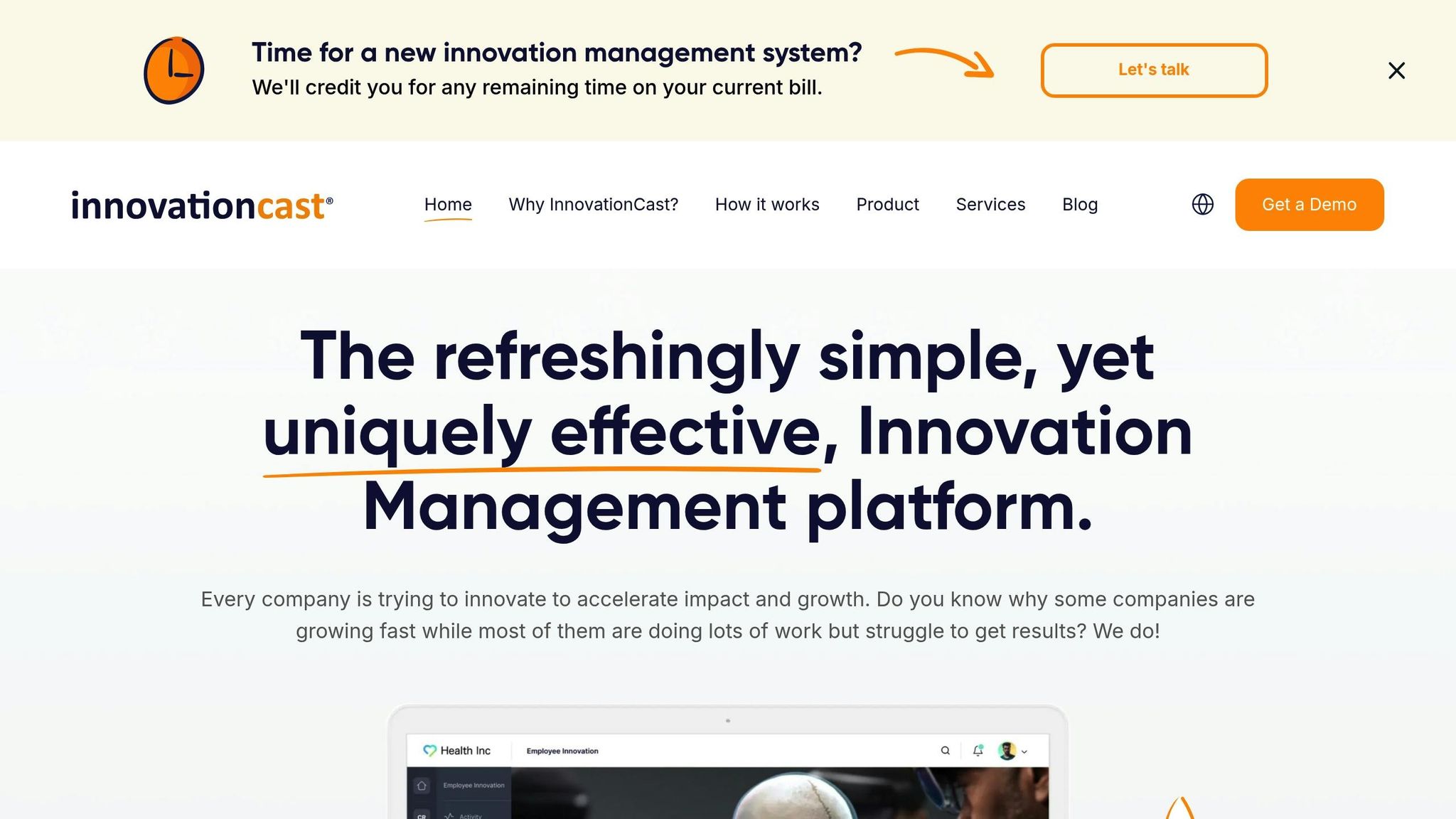
InnovationCast is recognized as one of the leading innovation and idea management platforms for 2025. It helps organizations turn scattered ideas into structured, actionable innovation programs that drive measurable business results.
This platform supports the entire innovation lifecycle, from capturing ideas to evaluating them with structured workflows and tracking their progress through implementation. It’s designed to create targeted campaigns addressing key business challenges. Let’s break down what makes InnovationCast stand out in idea management and team collaboration.
Idea Capture and Management
InnovationCast offers customizable submission forms tailored to specific campaigns, making it easier to gather ideas. Once submitted, ideas are processed through structured workflows, with criteria such as feasibility, potential impact, resource requirements, and alignment with strategic goals guiding their journey.
Users can organize ideas by factors like business unit, strategic alignment, or type of innovation. The platform ensures ideas move smoothly through stages - from submission and evaluation to development and implementation - so promising concepts don’t fall through the cracks. This ensures resources are directed toward the most impactful initiatives.
Collaboration and Engagement Tools
Collaboration is a key feature of InnovationCast. The platform includes tools like comments, voting, and discussion threads, allowing teams to refine and enhance ideas collectively. Notifications keep stakeholders informed about the progress of submissions, encouraging active engagement.
Activity feeds provide real-time updates, giving teams visibility into ongoing innovation efforts and fostering a sense of connection within the organization’s innovation ecosystem.
Integration with Other Software
InnovationCast is designed to work seamlessly with other enterprise tools. Its API access ensures that approved ideas can be easily integrated into existing project management systems, streamlining the transition from concept to execution.
For specific integration needs, it’s recommended to consult directly with InnovationCast to confirm compatibility with your current technology stack and workflows.
Pricing Models
InnovationCast uses a subscription-based pricing model that adjusts based on the number of users, selected features, and customization options. For exact pricing details, you’ll need to contact their team directly.
When considering costs, factors such as the size of your team, desired features, implementation support, training needs, and ongoing customer service should be taken into account. Many platforms in this space also offer annual contracts with discounts for larger deployments, which could be a smart choice for bigger organizations.
9. IdeaWake
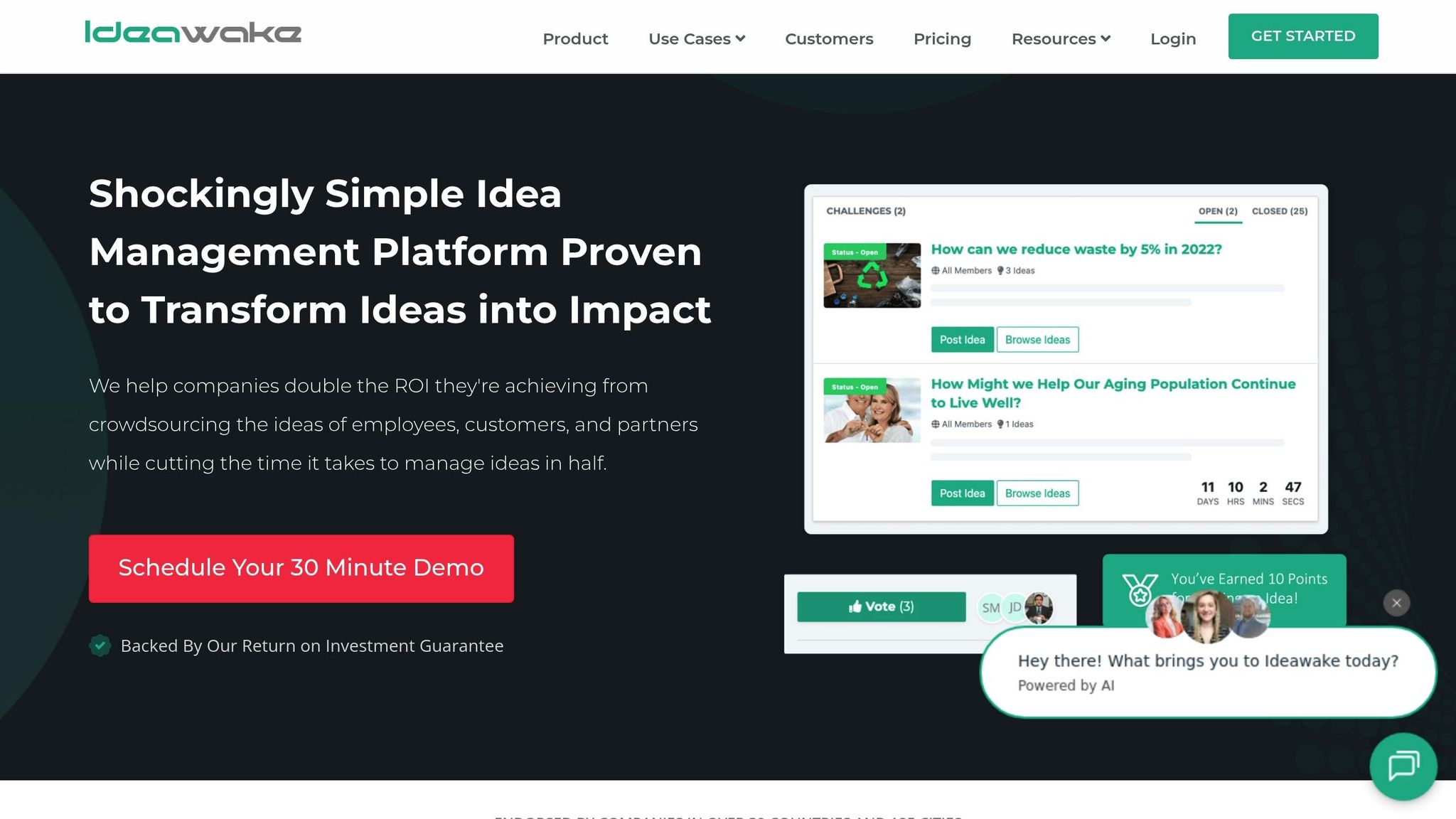
IdeaWake is a straightforward innovation management platform designed for organizations aiming to quickly roll out innovation programs. Its focus on simplicity and speed makes it especially appealing to mid-sized companies launching their first innovation initiative or those looking for a faster return on their investment.
What makes IdeaWake stand out is its priority on ease of use and accessibility. Unlike many platforms that require extensive setup and training, IdeaWake is designed to get teams started with minimal hassle. This makes it a great choice for businesses without dedicated innovation teams but eager to gather ideas from employees, customers, and partners. Here’s a closer look at how IdeaWake handles idea capture, collaboration, integration, and pricing.
Idea Capture and Management
IdeaWake provides customizable submission forms tailored to specific campaigns, making it easy to collect ideas. The platform features visual idea boards, offering teams a clear overview of all submitted concepts. Ideas can be sorted and filtered by different criteria, helping managers identify which ones deserve more attention.
The platform supports both internal and external idea collection, allowing businesses to gather input from employees while also engaging customers and partners. This flexibility opens the door to a wider range of creative insights.
Built-in analytics tools help track idea submissions and measure their potential impact. These insights allow managers to spot trends, assess engagement, and make informed decisions about which ideas to pursue.
Collaboration and Engagement Tools
IdeaWake includes features like discussion forums, voting systems, and commenting options, making it easy for teams to refine ideas together. This collaborative approach helps improve concepts while fostering engagement across the organization.
Social sharing tools ensure ideas gain visibility, allowing users to share concepts with relevant stakeholders. This reduces the risk of good ideas being lost due to communication gaps or organizational silos.
The platform is designed to make participation simple and rewarding, keeping teams motivated and maintaining momentum in innovation initiatives.
Integration Capabilities with Other Software
IdeaWake can integrate with various business tools, though specifics depend on your organization's needs. Potential integrations might include HR systems for managing users, project management tools for moving approved ideas into development, and CRM platforms for incorporating customer feedback.
These integrations streamline workflows by connecting innovation efforts with existing business operations. Once ideas are approved, they can transition smoothly into project management systems without manual data entry.
For businesses with unique integration needs, discussing compatibility directly with the IdeaWake team is recommended to ensure the platform fits seamlessly into your existing technology setup.
Pricing Models
IdeaWake uses a subscription-based pricing system, with details available upon request. Their pricing likely includes tiered plans to suit different business sizes and feature requirements.
When considering costs, think about factors like the number of active users, the level of customization needed, and integration requirements. For larger organizations or those needing advanced features, enterprise licensing options might be available.
To get a clear understanding of how IdeaWake's costs align with your budget and expected outcomes, it’s best to contact their team directly. They can provide tailored pricing information and help you evaluate the platform’s potential return on investment.
10. Aha! Ideas
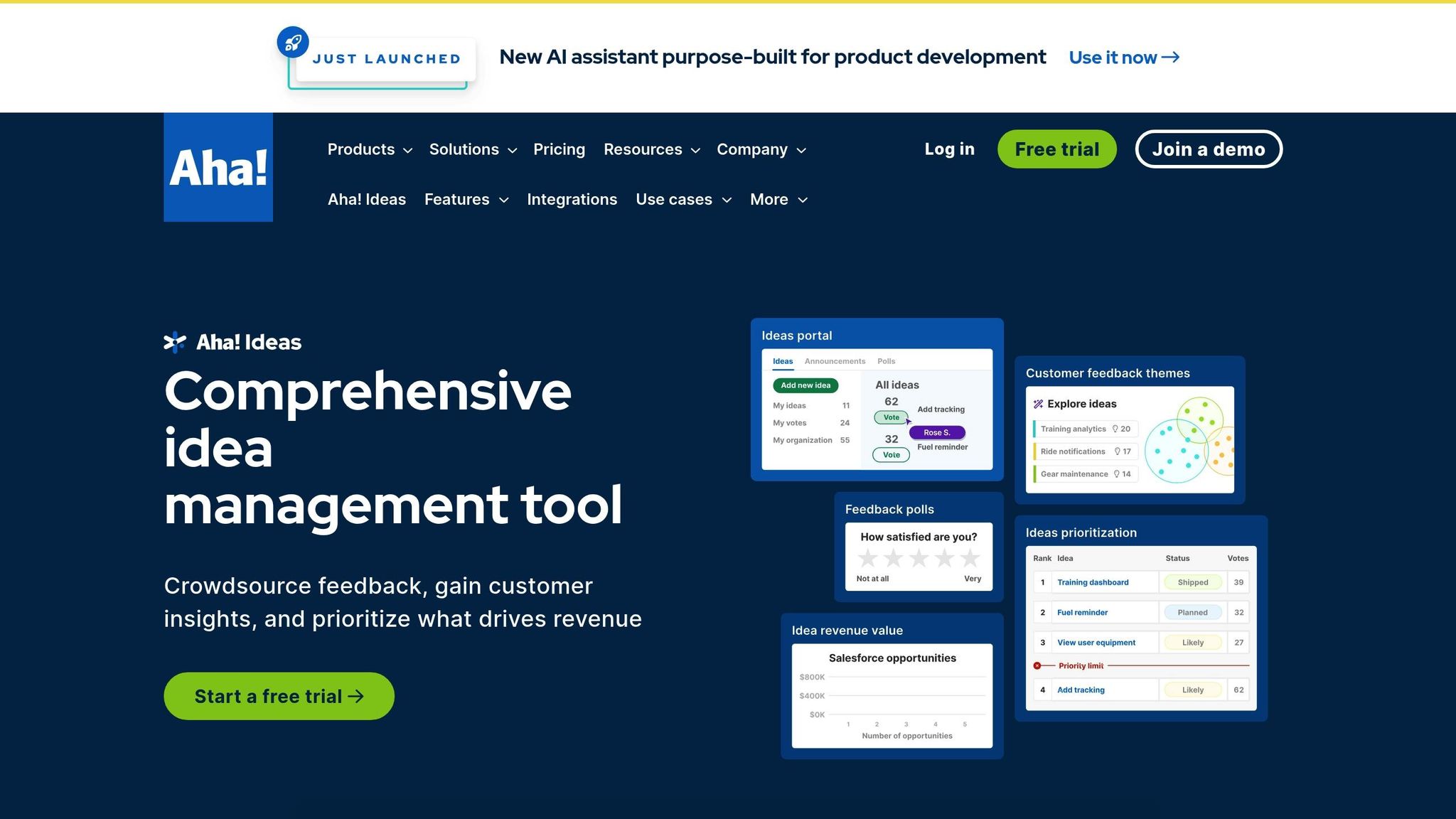
Aha! Ideas bridges the gap between brainstorming and turning those ideas into actionable product plans. It’s a one-stop platform designed to help organizations take creative concepts and seamlessly turn them into structured product development roadmaps.
What sets Aha! Ideas apart is its focus on transparency and traceability. From the moment an idea is submitted to its eventual implementation, every step is clearly documented, making decision-making more straightforward. With over 5,000 organizations worldwide using the platform and a user satisfaction score of 8.7/10 according to SoftwareReviews, it’s clear that Aha! Ideas delivers results.
Here’s a closer look at how Aha! Ideas supports organizations with tools for idea capture, collaborative refinement, smooth integrations, and flexible pricing.
Idea Capture and Management
Aha! Ideas provides customizable portals for collecting ideas, whether from your internal team, customers, or partners. These portals are adaptable, making it easy to gather input from various sources.
The platform also includes AI-powered scoring tools to quickly identify the most promising ideas. You can organize submissions with tags, categories, and workflows that match your internal review processes. Plus, the option for anonymous submissions encourages honest feedback and fresh perspectives.
On top of that, analytics tools help track how ideas progress and align with your strategic goals. This data-driven approach ensures that the best ideas don’t just get noticed - they get acted on.
Collaboration and Engagement Tools
Collaboration is at the heart of Aha! Ideas. Features like discussion threads, voting systems, and feedback tools make it easy for teams to work together on refining ideas. These tools help build consensus and keep the innovation process moving.
The platform also supports themed challenges, which let teams focus on specific goals or business needs. Stakeholders can comment on ideas, upvote their favorites, and share insights to strengthen proposals. Gamification features, like recognizing top contributors, create an engaging environment that rewards participation and fosters a culture of innovation.
Integration Capabilities with Other Software
To make workflows smoother, Aha! Ideas integrates with popular tools like Jira, Slack, Microsoft Teams, and Salesforce. These integrations ensure that data flows seamlessly between platforms, reducing manual work.
Its connection with Aha! Roadmaps is especially useful, as it allows approved ideas to move directly into product planning. With role-based access controls, compliance features, and API access for custom setups, the platform is well-suited for enterprise-level needs.
Pricing Models
Aha! Ideas offers a subscription-based pricing model with options to fit different organizational needs:
| Plan | Price (per user/month) | Key Features |
|---|---|---|
| Essentials | $39 (billed annually) | Core idea management, basic analytics, standard integrations |
| Advanced | $59 (billed annually) | AI scoring, advanced analytics, automation, advanced integrations |
| Enterprise | Custom pricing | Enhanced security, compliance, dedicated support, and advanced customization |
All prices are in US dollars. A free trial is available, and discounts may apply for annual billing or larger teams. Enterprise plans offer tailored solutions with added features like advanced security and dedicated support, making them ideal for larger organizations with complex needs.
Platform Comparison Chart
Selecting the right innovation management platform depends on how well each option meets your organization's specific needs. Below is a chart summarizing the key strengths, pricing, and use cases for ten leading platforms.
| Platform | Best For | Key Strengths | Main Limitations | Starting Price | User Ratings |
|---|---|---|---|---|---|
| ITONICS | Trend analysis and foresight | Advanced visualization, comprehensive trend monitoring, deep analytics | High cost (starting at five figures) and lacks project management features | $10,000+ annually | Not specified |
| Brightidea | Enterprise-grade innovation | Extensive features, robust reporting, strong backend management, great support | Steep learning curve, outdated interface, requires professional services | Custom pricing | 4.2/5 (G2), 4.4/5 (Capterra) |
| Strategyzer | Business model innovation | Business Model Canvas, real-time collaboration, no per-user charges, Excel/PowerPoint integration | Narrow focus on brainstorming and higher pricing | Custom pricing | 4.3/5 (G2) |
| IdeaScale | Community engagement and ideas | Intuitive interface, great support, quick setup, flexible customization | Limited enterprise-grade features for complex workflows | Custom pricing | Not specified |
| Planbox | Flexible innovation management | Highly adaptable platform for various innovation types | Custom workflows may require multiple touchpoints | $2.00 per user/month | Not specified |
| Qmarkets | Enterprise innovation ecosystems | Strong idea sourcing, trend detection, and easy self-service configuration | Not specified | Custom pricing | Not specified |
| HYPE Innovation | Expert-led program development | Outstanding support, collaborative approach, gamification, rapid implementation | Rigid interface configuration and pricing challenges for smaller businesses | Custom pricing | 4.3/5 (G2), 4.4/5 (Capterra) |
| InnovationCast | Mid-market innovation management | Balanced features, reasonable pricing, scalable | Limited advanced AI capabilities | Custom pricing | Not specified |
| IdeaWake | Simple idea management | Easy setup, user-friendly interface, quick deployment | Basic features with limited customization | Custom pricing | Not specified |
| Aha! Ideas | Product development integration | Seamless roadmap integration, AI-powered scoring, strong analytics | Primarily focused on product innovation | $39.00 per user/month | 8.7/10 (SoftwareReviews) |
This comparison highlights each platform's strengths and helps you align them with your innovation goals.
Pricing Structure Patterns
The review reveals distinct pricing trends among these platforms. Enterprise solutions like ITONICS and Brightidea often require custom quotes and involve significant annual commitments. Meanwhile, mid-market options such as Planbox offer straightforward per-user pricing. Platforms like Aha! Ideas cater to product-focused teams with transparent, tiered pricing models.
Feature Depth Comparison
Feature depth varies widely. Comprehensive platforms like Brightidea and HYPE Innovation provide extensive customization but can require substantial training and setup. On the other hand, specialized tools like Strategyzer focus on structured innovation methods, while balanced platforms like Aha! Ideas and IdeaScale offer essential features with easier adoption. Generally, there’s a trade-off between feature depth and ease of use - Brightidea’s robust tools may feel complex, whereas IdeaScale’s intuitive design makes it quick to implement.
Integration and Scalability
Integration capabilities are another key differentiator. It's crucial to evaluate whether a platform integrates seamlessly with your existing tools and supports your scalability needs as your organization grows.
Support and Implementation
Customer support quality can make or break the user experience. HYPE Innovation is frequently praised for its exceptional support and collaborative approach, while Brightidea also earns high marks for its service. Smaller platforms might offer quicker response times, but their support options could be more limited.
This chart and analysis provide a clear snapshot of the top innovation management platforms, helping you make an informed decision based on your organization’s priorities and challenges.
Final Thoughts
Selecting the right innovation platform for 2025 comes down to matching your organization’s unique needs with the features and capabilities of each option. The platforms highlighted here take notably different approaches - ranging from ITONICS, with its robust trend analysis tools, to IdeaScale, known for its straightforward, community-driven interface. Each caters to specific organizational goals and financial considerations.
Budget is often a deciding factor. Enterprise-level solutions like ITONICS can cost upwards of six figures annually for larger teams, while others offer more straightforward, per-user pricing models. Understanding your organization's financial limitations will help narrow down the choices.
Another key consideration is the balance between feature depth and usability. Platforms like HYPE Innovation offer extensive customization and advanced capabilities, but they may require significant setup time and user training. On the other hand, solutions like IdeaScale prioritize simplicity and quick deployment, making them ideal for organizations looking to engage communities without the need for extensive customization.
The technological edge of a platform is increasingly critical. AI-powered tools are revolutionizing how organizations evaluate ideas, detect trends, and automate workflows. Choosing a platform with advanced AI capabilities can streamline decision-making and ensure better resource allocation, giving your organization an edge in a competitive market.
For small businesses, intuitive and budget-friendly platforms like IdeaWake provide practical solutions. Larger enterprises, however, often require more comprehensive features and seamless integrations, as seen with platforms like ITONICS and HYPE Innovation.
To make an informed decision, take advantage of demos or trial access to evaluate the platform’s usability in real-world scenarios. Involving key stakeholders during the evaluation process and preparing for user training and change management are crucial steps for successful implementation.
For US-based businesses, additional resources like BizBot can offer curated directories of management tools that complement your innovation strategy and streamline operational processes.
Finally, map out your innovation workflows, define clear success metrics, and ensure that your chosen platform aligns with your strategic objectives. The right platform won’t just manage ideas - it will revolutionize how your organization captures, develops, and executes them, driving meaningful change and growth.
FAQs
What factors should I consider when selecting an innovation management platform that fits my organization's needs and budget?
When picking the right innovation management platform, the first step is to pinpoint your organization’s unique needs. Are you aiming to improve collaboration, keep track of ideas, or simplify project workflows? Defining these goals will help you narrow down your options.
Budget is another key factor. Look for platforms that offer flexible pricing models so they can grow alongside your business.
Don’t forget to assess essential features like user-friendliness, compatibility with your existing tools, and the ability to customize the platform to fit your processes. Platforms that cater to businesses of all sizes can also be a smart choice, as they make it easier to adjust as your requirements change over time.
How do AI-driven features differ from traditional tools in innovation management platforms?
AI-powered tools in innovation management platforms bring a new level of efficiency and insight by using advanced algorithms to handle complex tasks. They can process massive datasets, automate repetitive workflows, and even offer predictive insights. For instance, AI can analyze historical data or market trends to suggest forward-thinking solutions, saving time and boosting creativity.
In contrast, traditional tools rely heavily on manual inputs and follow rigid, predefined workflows. While they work well for structured tasks, they don’t adapt or learn in real time like AI systems can. The standout advantage of AI lies in its ability to continuously learn and adjust, making it an invaluable asset for businesses looking to stay competitive in fast-moving markets.
How do integration features in innovation management platforms improve workflows and drive innovation?
Integration features in innovation management platforms can transform the way your team works by linking these tools with the software and systems you rely on daily. This kind of connectivity simplifies data sharing, cuts down on repetitive manual tasks, and fosters better collaboration across different platforms.
By bringing processes together and keeping information centralized, these integrations let organizations concentrate on coming up with creative ideas and turning them into action. For instance, syncing your platform with project management tools or communication apps can make the shift from brainstorming to execution much more seamless, leading to stronger, more effective outcomes.

